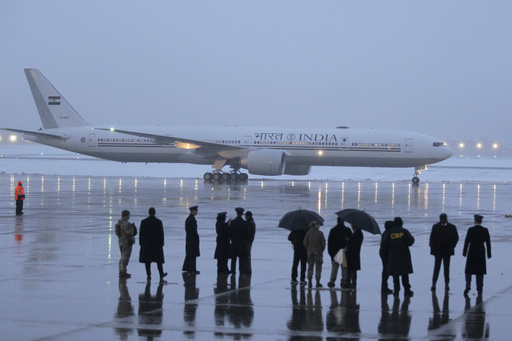WASHINGTON — On Thursday, President Donald Trump met with India’s Prime Minister Narendra Modi, who has been vocal in his admiration for Trump and is seeking to evade tariffs recently introduced by the new U.S. administration.
Modi, a nationalist leader, has highlighted the positive dynamic between himself and Trump throughout Trump’s first term, celebrating his return to the presidency. The Indian Prime Minister aims to enhance relations with the U.S. and the broader Western world, which have become strained due to Modi’s reluctance to denounce Russia’s invasion of Ukraine.
This meeting follows a significant electoral win for Modi’s ruling Hindu nationalist party in a crucial state assembly election in India last weekend, which includes New Delhi. Before departing for Washington, Modi expressed his intentions for the trip, viewing it as an opportunity to “deepen our partnership” in important domains such as technology, trade, defense, and energy.
However, the atmosphere at the White House may not be entirely positive. Trump, serving as a Republican president, has previously initiated tariffs on China and has indicated further measures will target the European Union, along with similar threats against Canada and Mexico. Trump announced on Thursday his plans to raise U.S. tariffs to align with those imposed by other nations, stating on his social media account, “TODAY IS THE BIG ONE: RECIPROCAL TARIFFS!!!”
Trump has often referred to India as a “tariff king.” In a bid to promote trade, New Delhi has shown interest in importing more American oil while simultaneously reducing tariffs on certain U.S. products, including a decrease for Harley-Davidson motorcycles from 50% to 40%.
In 2023, India also eliminated retaliatory tariffs on U.S. almonds, apples, lentils, chickpeas, and walnuts. Additionally, there’s been a recent agreement allowing General Electric, based in the U.S., to collaborate with India’s Hindustan Aeronautics to manufacture jet engines for local aircraft and the procurement of armed MQ-9B SeaGuardian drones from the United States.
Despite these developments, Trump continues to criticize the U.S. trade deficits, expressing his commitment to reducing them during a previous meeting with Japan’s Prime Minister Shigeru Ishiba. The U.S. is India’s top trading partner, but there remains a substantial trade deficit of $50 billion in favor of India.
In 2023, the trade between India and the U.S. reached approximately $190.1 billion. According to India’s External Affairs Ministry, U.S. exports to India amounted to nearly $70 billion, while imports were valued at $120 billion.
A Trump administration official, speaking on the condition of anonymity, provided insights on Thursday regarding the anticipated meeting, indicating that India has made modest advancements in trade relations. The official conveyed aspirations of reaching a bilateral trade agreement with India by the end of the year that both parties would consider equitable.
Modi’s agenda for the day included a session with national security adviser Mike Waltz, along with separate discussions with Elon Musk, the billionaire SpaceX founder, and Vivek Ramaswamy, a former GOP presidential candidate who is preparing to run for governor of Ohio.
During their conversation, Modi and Trump also planned to address immigration issues. Modi highlighted that India accepted the return of 104 migrants transported back via a U.S. military flight — noted as the first such operation as part of the Trump administration’s immigration enforcement efforts at the U.S.-Mexico border.
From the perspective of the Trump administration, India is perceived as a crucial component of its strategy to counter China in the Indo-Pacific region. Later this year, India will host a summit for the Quad, a group consisting of the U.S., India, Japan, and Australia.
